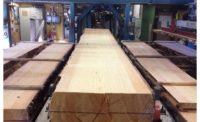A long-running North American trade battle is intensifying following a Commerce Dept. finding that Canada has been subsidizing softwood lumber sales to the U.S. and will be hit with tariffs of up to 24% on those shipments.
Commerce Secretary Wilbur Ross said the U.S. will collect cash deposits from Canada starting April 25, totaling about $1 billion a year. It also will charge retroactive payments going back 90 days, amounting to an additional $250 million, he estimated. Softwood lumber is used in constructing single-family homes.
The countervailing duties range from about 3% to more than 24%, depending on the lumber-producing company.
Top Canadian government officials blasted the Commerce Dept.’s April 24 preliminary finding. Minister of Natural Resources Jim Carr and Minister of Foreign Affairs Chrystia Freeland said in a joint statement that the tariff is “unfair and punitive.” They added, “The accusations are baseless and unfounded.”
Canada “will vigorously defend the interests of the Canadian softwood lumber industry, including litigation,” Carr and Freeland said. They added that Canada has won past rulings regarding lumber shipments to the U.S. in international tribunals.
U.S. lumber producers, which filed a complaint last year that led to the Commerce Dept. finding, hailed the decision. Cameron Krauss, U.S. Lumber Coalition legal chair, said in a statement that the department’s action “confirms that Canadian lumber mills are subsidized by their government and benefit from timber pricing policies and other subsidies which harm U.S. manufacturers and workers.”
Susan Yurkovich, president of the Vancouver-based BC Lumber Trade Council, said, “The allegations made by the U.S. lumber lobby are the same arguments they made in prior rounds of litigation, all of which were rejected and overturned by independent [North American Free Trade Agreement] panels.”
A final determination on the countervailing duties is slated for Sept. 7.
The countervailing duty finding “is only the first shoe to drop,” a Canadian government official says. Further action by Commerce is slated for June 23, when it is to issue a preliminary determination whether Canada engaged in dumping its lumber in the U.S.—selling the product at less than fair value.
Dumping duties, if imposed, would be added to the countervailing duties. Although Commerce has yet to make a dumping determination, Ross said in a press briefing at the White House that Canada has been “dumping lumber.”
Scott Moss, president of Moss & Associates, a Fort Lauderdale-based construction-management firm, said in an email, "The new stance on Canadian lumber will have a big effect on our stick-frame work." He adds that increased lumber prices "will cause some waves in the multifamily market."
Moss also notes that U.S lumber supplies "can't keep up with the demand."
The National Association of Home Builders slammed the Commerce Dept. action, saying that it will harm U.S. consumers and cost jobs. Paul Emrath, NAHB senior economist, said that for all of 2017, the nearly 20% duty would result in a loss of 6,241 full-time U.S. jobs, many in the construction industry, as well as $498.3 million in lost wages and salaries.
NAHB Chairman Grainger MacDonald said in a statement, “Clearly, protectionist measures to prop up domestic lumber producers at the expense of millions of U.S. home buyers and lumber users is not the way to resolve the U.S.-Canada trade dispute or boost the U.S. economy.
The Commerce Dept. said softwood lumber imports from Canada to the U.S. were estimated at $5.7 billion in 2016. Ross said Canadian shipments accounted for about 31.5% of the U.S. market.
Canada is “an important ally,” Ross told reporters in a White House briefing on April 25. “They’re generally a good neighbor.” He added, “That doesn’t mean they don’t have to play by the rules.”
Canadian litigation will not come right away, a government official says. He said the country must wait until a final combined-duty rate is set in November or December, and the U.S. International Trade Commission confirms that rate in December or January.
Story updated on April 26 to clarify NAHB economic-impact time frame; also adding comments from Moss & Associates.


